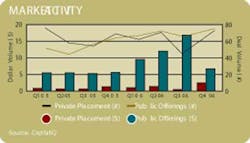Automation Vendors Tap Capital
The recent relative rise in valuations experienced by automation companies would be expected to encourage them to take advantage of these favorable conditions to raise additional equity capital. This is precisely what they have done.In 2006, automation companies accessed the North American public equity markets to raise some $33.2 billion. This represented an increase of 174 percent over the amount of equity raised in 2005. Automation companies also took advantage of the stronger balance sheets afforded them by this additional equity capital to increase their access to leverage, as they tapped the public debt markets for more than $11.8 billion in 2006. This represented an increase of 21 percent compared to 2005. This high ratio of equity-to-debt capital raised in 2006 indicates further that the sector as a whole used its access to public markets to deleverage; the implied market equity to capitalization ratio of 74 percent for capital raised in 2006 lies considerably above the sector’s aggregate capitalization structure of 63 percent at Dec. 31, 2005. Popular fears that low interest rates have encouraged “Corporate America ” to overindulge in cheap debt and easy credit would appear inappropriate, at least with regard to the automation sector.Rising transaction sizeNot only did the aggregate amount of public capital procured by automation companies rise significantly in 2006, but the average size of each capital raise also grew, with average transaction size in 2006 rising some 60 percent, to more than $165 million, as compared to an average transaction of some $104 million in 2005. The number of capital transactions, the aggregate amount of capital raised and the average amount of each transaction all have displayed an upward trend, with the fourth quarter 2006 (on a dollar volume basis) comprising a notable reversal. It remains to be seen whether this decline signaled a secular shift or merely a typical dip in activity seen in North America during the fourth quarter, when the holiday season significantly reduces the number of days that issuers can effectively access the public markets.Private capital markets have manifested similar trends, with available data indicating that more than $5.3 billion of equity was raised in private markets by automation companies in 2006, a 61 percent increase over 2005. Because they
can occur completely outside the public realm, less information is available about private market transactions than about public.
A significant exception is a vehicle called a “PIPE,” or a private investment in public equity. The vast majority of
the sector’s private capital was raised through this vehicle, which allows issuers to raise capital quickly by selling
unregistered securities, typically through an investment bank, and avoiding the lengthy and sometimes difficult registration process. These securities can be structured equities or simple common stock, identical to that already trading; usually the issueras part of the PIPE transaction agrees to begin the registration process for the securities or otherwise to facilitate investor liquidity.Private market transactions are generally smaller than public ones, with the average transaction for automation companies in 2006 being approximately $21 million, or less than one-seventh the size of a public deal. Nonetheless, the private markets in 2006 saw the same trend toward increasing transaction size manifested in the public markets, as this $21 million represented an increase of some 62 percent over the $13 million average size seen in 2005. Both economic and management theory dictate that businesses access capital primarily to invest. Recent activity would therefore suggest that automation companies believe robust investment opportunities exist in their businesses. If this belief proves correct, one would expect future growth in the sector, driven by this increased application of capital. Only time will tell, however, whether this capital is wisely invested. Alan J. Canzano, [email protected], is a Principal at Cronus Partners LLC (www.CronusPartners.com), an investment banking firm specializing in automation technology. Nothing contained in this article is to be considered the rendering of financial, investment or professional advice for specific circumstances. Readers are responsible for obtaining such advice from professional advisors and are encouraged to do so.
can occur completely outside the public realm, less information is available about private market transactions than about public.
A significant exception is a vehicle called a “PIPE,” or a private investment in public equity. The vast majority of
the sector’s private capital was raised through this vehicle, which allows issuers to raise capital quickly by selling
unregistered securities, typically through an investment bank, and avoiding the lengthy and sometimes difficult registration process. These securities can be structured equities or simple common stock, identical to that already trading; usually the issueras part of the PIPE transaction agrees to begin the registration process for the securities or otherwise to facilitate investor liquidity.Private market transactions are generally smaller than public ones, with the average transaction for automation companies in 2006 being approximately $21 million, or less than one-seventh the size of a public deal. Nonetheless, the private markets in 2006 saw the same trend toward increasing transaction size manifested in the public markets, as this $21 million represented an increase of some 62 percent over the $13 million average size seen in 2005. Both economic and management theory dictate that businesses access capital primarily to invest. Recent activity would therefore suggest that automation companies believe robust investment opportunities exist in their businesses. If this belief proves correct, one would expect future growth in the sector, driven by this increased application of capital. Only time will tell, however, whether this capital is wisely invested. Alan J. Canzano, [email protected], is a Principal at Cronus Partners LLC (www.CronusPartners.com), an investment banking firm specializing in automation technology. Nothing contained in this article is to be considered the rendering of financial, investment or professional advice for specific circumstances. Readers are responsible for obtaining such advice from professional advisors and are encouraged to do so.

